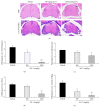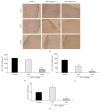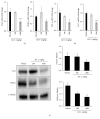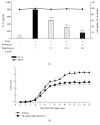Alpinia oxyphylla Fruit Extract Ameliorates Experimental Autoimmune Encephalomyelitis through the Regulation of Th1/Th17 Cells
- PMID: 31001353
- PMCID: PMC6437745
- DOI: 10.1155/2019/6797030
Alpinia oxyphylla Fruit Extract Ameliorates Experimental Autoimmune Encephalomyelitis through the Regulation of Th1/Th17 Cells
Abstract
Alpinia oxyphylla is a traditional Chinese medicine widely used for treating diarrhea, ulceration, and enuresis. Moreover, A. oxyphylla is effective for cognitive function improvement and nerve regeneration. Multiple sclerosis (MS) is a chronic neuronal inflammatory autoimmune disease that commonly affects young adults in high-latitude regions. The aim of this study was to evaluate the beneficial effects of A. oxyphylla in an experimental autoimmune encephalomyelitis (EAE) mouse model, which is an extensively used model for human MS. The ethanolic extract of A. oxyphylla fruit (AO-1) was orally administered to EAE mice. Our results showed AO-1 significantly reduced EAE symptoms. Histopathological analysis showed AO-1 reduced demyelination, inflammation, gliosis, and axonal swelling in the spinal cord. Furthermore, immunohistochemistry and quantitative polymerase chain reaction (qPCR) studies revealed that the infiltration of CD4+, CD8+ T cells, and CD11b+ monocytes into the spinal cord decreased in the AO-1-treated group. Mechanistically, the Th1 transcription factor T-bet, Th17 transcription factor retinoic acid receptor-related orphan receptor γ (RORγt), and inflammatory cytokines interferon (IFN)-γ and interleukin (IL)-17 were reduced in the spinal cords of mice treated with AO-1. The expression levels of T-bet and RORγt were also lowered in the spleens of those mice. Further in vitro study showed AO-1 inhibited production of IFN-γ, IL-2, and tumor necrosis factor-α from MOG35-55-peptide-stimulated splenocytes. One component isolated from AO-1, yakuchinone A, inhibited IL-17 production in vitro and reduced EAE symptoms in the mice. Collectively, our results indicate that AO-1 ameliorated the severity of EAE in mice and may involve the regulation of Th1/Th17 response. A. oxyphylla warrants further investigation, particularly regarding its clinical benefits for MS.
Figures








Similar articles
-
Rapamycin Ameliorates Experimental Autoimmune Encephalomyelitis by Suppressing the mTOR-STAT3 Pathway.Neurochem Res. 2017 Oct;42(10):2831-2840. doi: 10.1007/s11064-017-2296-7. Epub 2017 May 30. Neurochem Res. 2017. PMID: 28600752
-
IFN-β regulates Th17 differentiation partly through the inhibition of osteopontin in experimental autoimmune encephalomyelitis.Mol Immunol. 2018 Jan;93:20-30. doi: 10.1016/j.molimm.2017.11.002. Epub 2017 Nov 8. Mol Immunol. 2018. PMID: 29127843
-
Infiltration of Th1 and Th17 cells and activation of microglia in the CNS during the course of experimental autoimmune encephalomyelitis.Brain Behav Immun. 2010 May;24(4):641-51. doi: 10.1016/j.bbi.2010.01.014. Epub 2010 Feb 6. Brain Behav Immun. 2010. PMID: 20138983
-
Green tea EGCG, T cells, and T cell-mediated autoimmune diseases.Mol Aspects Med. 2012 Feb;33(1):107-18. doi: 10.1016/j.mam.2011.10.001. Epub 2011 Oct 14. Mol Aspects Med. 2012. PMID: 22020144 Review.
-
Th17 cell, the new player of neuroinflammatory process in multiple sclerosis.Scand J Immunol. 2011 Jul;74(1):1-13. doi: 10.1111/j.1365-3083.2011.02536.x. Scand J Immunol. 2011. PMID: 21338381 Review.
Cited by
-
Renal protective effects of Alpinate Oxyphyllae Fructus and mesenchymal stem cells co-treatment against D- galactose induced renal deterioration.Int J Med Sci. 2024 May 27;21(8):1491-1499. doi: 10.7150/ijms.96007. eCollection 2024. Int J Med Sci. 2024. PMID: 38903928 Free PMC article.
-
Synergistic Impacts of Alpinia oxyphylla Seed Extract and Allopurinol against Experimental Hyperuricemia.Biomed Res Int. 2022 Jun 11;2022:2824535. doi: 10.1155/2022/2824535. eCollection 2022. Biomed Res Int. 2022. PMID: 35726318 Free PMC article.
-
Natural Products and Their Bioactive Compounds: Neuroprotective Potentials against Neurodegenerative Diseases.Evid Based Complement Alternat Med. 2020 Feb 14;2020:6565396. doi: 10.1155/2020/6565396. eCollection 2020. Evid Based Complement Alternat Med. 2020. PMID: 32148547 Free PMC article. Review.
-
Role of Network Pharmacology in Prediction of Mechanism of Neuroprotective Compounds.Methods Mol Biol. 2024;2761:159-179. doi: 10.1007/978-1-0716-3662-6_13. Methods Mol Biol. 2024. PMID: 38427237
-
Comparative transcriptome analysis of Alpinia oxyphylla Miq. reveals tissue-specific expression of flavonoid biosynthesis genes.BMC Genom Data. 2021 Jun 5;22(1):19. doi: 10.1186/s12863-021-00973-4. BMC Genom Data. 2021. PMID: 34090339 Free PMC article.
References
LinkOut - more resources
Full Text Sources
Research Materials

